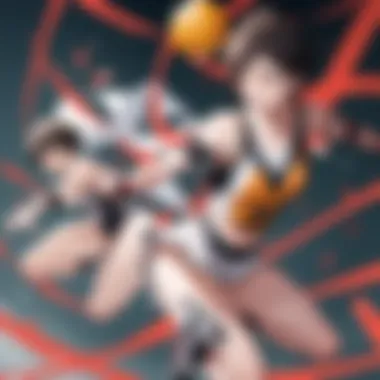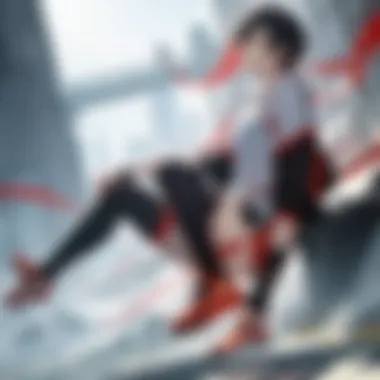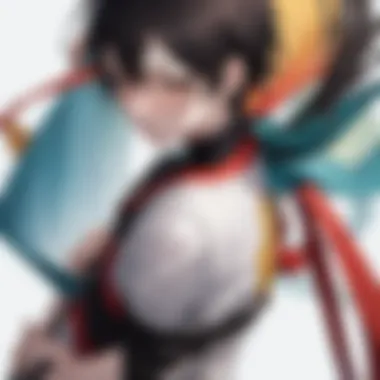Exploring Haikyuu: The Depth of Its Universe


Intro
Haikyuu!! emerges as a prominent title within the anime and manga sphere. This series captivates its audience not only through engaging volleyball matches but also by presenting profound character arcs and emotional depth. It transcends mere sports narrative, diving into themes of teamwork, rivalry, and personal growth. To fully appreciate the series, one must understand its overview, key characters, and the underlying themes that make it unique. This exploration aims to provide a well-rounded perspective on Haikyuu, offering insights for both casual viewers and serious fans alike.
Series Overview
Synopsis and Premise
Haikyuu!!, created by Haruichi Furudate, revolves around Shoyo Hinata, a determined high school student who aspires to become a volleyball star despite his short stature. The story begins with Hinata witnessing a powerful player known as the "Little Giant” during a volleyball game, fueling his dream to compete. He joins the Karasuno High School volleyball team, where his journey unfolds among challenges, friendships, and intense competition. The narrative moves beyond mere play, emphasizing personal development and relationship building among teammates.
Notable Characters
The character roster in Haikyuu!! is extensive, yet a few stand out notably:
- Shoyo Hinata: The enthusiastic protagonist, known for his determination and agility on the court.
- Tobio Kageyama: A talented setter, whose complex relationship with Hinata evolves into a strong partnership.
- Daichi Sawamura: The captain of Karasuno, embodying leadership and responsibility.
- Toru Oikawa: A rival setter from Aoba Johsai High School, he adds depth through his competitive spirit and personal struggles.
- Yamaguchi Tadashi: A shy yet determined player, showcasing character growth throughout the series.
These characters are not just athletes; they reflect diverse human experiences, making the story relatable.
Themes and Motifs
Major Themes Explored
The series delves into several key themes that resonate with viewers:
- Teamwork and Collaboration: Central to Haikyuu!! is the necessity of working together. Each character, despite their individual talents, must learn to play as a cohesive unit.
- Overcoming Adversity: Characters face various obstacles, both internal and external, emphasizing resilience and the importance of perseverance.
- Personal Growth: As matches unfold, characters develop not just athletically but emotionally, showing maturity and self-awareness.
Symbolism in Storytelling
Symbolism plays a significant role in Haikyuu!! while enhancing its narrative:
- The Volleyball: Represents teamwork, goals, and the bouncing back from failures.
- The Court: Serves as a stage for personal battles, reflecting the struggles and triumphs of the characters within the realm of sports.
"Haikyuu!! is not just about volleyball; it’s about how we rise through challenges and grow together."
Artistic Style and Animation
Visual Aesthetics and Design
Haruichi Furudate’s artwork complements the narrative effectively. The character designs are distinctive, capturing each personality through visual elements. The use of expressive facial features and dynamic postures during matches enhances the emotional stakes of the games.
Animation Techniques and Trends
The anime adaptation by Production I.G utilizes fluid animation techniques, especially during game sequences. The fast-paced movements and close-up shots during intense moments create a sense of urgency and excitement, engaging viewers. The blend of vibrant colors and well-crafted backgrounds contributes to the overall visual appeal, elevating the viewing experience to great extent.
By dissecting these elements, it becomes evident that Haikyuu!! is more than a sports anime. It offers richness in storytelling and character development, a fact that adds layers to its cultural significance. Understanding these aspects allows audiences to appreciate the series on a deeper level, encouraging discussions and analysis within the anime community.
Prelims to Haikyuu
In discussing the significance of Haikyuu, it is vital to consider its impact within the landscape of anime and manga. This series not only reflects the sport of volleyball but also brings forth deeper themes that resonate with audiences on multiple levels. Understanding Haikyuu provides insight into both cultural and personal development aspects, making it an essential topic in contemporary discussions about anime.
Overview of the Series


Haikyuu is an anime and manga series penned by Haruichi Furudate. It debuted in 2011, capturing the attention of readers and viewers alike with its portrayal of high school volleyball. The story revolves around Shoyo Hinata, a young athlete who aspires to become a top volleyball player despite his short stature. His determination drives the narrative, presenting challenges he faces and the personal growth he undergoes.
The series is much more than a sports narrative; it embodies concepts of teamwork, perseverance, and friendship. It illustrates how each character’s journey complements the whole, showing the importance of collaboration in achieving common goals. Whether one is a sports enthusiast or not, the messages embedded within the series are universally applicable and offer profound takeaways.
Origin and Creation
The inception of Haikyuu stems from the passion of Haruichi Furudate, who wanted to shed light on volleyball as a sport. The inspiration to create a narrative focused on volleyball arose from the desire to depict the struggles and triumphs within this dynamic setting. Furudate researched various aspects of volleyball, including techniques and team strategies, ensuring that viewers were provided with an authentic experience.
The blend of compelling storytelling and accurate depiction of volleyball matches has contributed significantly to its appeal. The series started serialization in Weekly Shōnen Jump, a prominent publication for shōnen manga, leading to a successful anime adaptation in 2014. The accessibility of both the manga and the anime has played a crucial role in broadening its audience, creating a cult following worldwide.
To grasp a deeper understanding of Haikyuu, one must appreciate the thought put into its origin and creation. This helps contextualize the themes and characters that will be discussed throughout the article.
Themes of Haikyuu
In any enduring series, themes serve as a backbone connecting the story to its audience. Haikyuu explores several important themes that resonate well with viewers and readers. Understanding these themes not only enhances appreciation of the series but also provides insight into broader experiences in sports and life.
Teamwork and Collaboration
At its core, Haikyuu emphasizes the value of teamwork and collaboration. Volleyball is not a solo sport; it requires trust and understanding among teammates. Throughout the series, characters often face challenges that test their ability to work together. The development of characters such as Shoyo Hinata and Tobio Kageyama highlights how individual skills merge into a cohesive unit. This theme reaffirms that success is often a collective effort, and personal growth is tied to the group’s achievements.
Additionally, teamwork extends beyond the court. The series demonstrates how relationships build resilience against adversity. Characters learn to communicate effectively, resolving conflicts and differences. These lessons reflect foundational elements of both sports and life, reinforcing that collaboration is essential for progress.
Perseverance and Growth
The theme of perseverance runs deeply throughout the narrative of Haikyuu. Characters face numerous obstacles, from physical limitations to intense competition. The journey of Shoyo Hinata is particularly illustrative of this theme. His relentless pursuit to improve his skills, despite his shorter stature, serves as an inspiring portrayal of determination. Each setback he encounters is met with resolve, illustrating the idea that personal challenges can lead to growth.
This theme speaks to audiences who value hard work and dedication. The series showcases that success does not simply come from talent but often relies on persistent effort. Ultimately, Haikyuu encapsulates the notion that setbacks can transform into stepping stones, making the journey all the more worthwhile.
Friendship and Rivalry
Haikyuu delves into the nuances of both friendship and rivalry. Characters form deep bonds, yet they also face rivals who push them to achieve more. This duality enriches the storyline, creating tensions that propel character development. For example, the dynamic between Hinata and Kageyama begins with rivalry but evolves into strong friendship, embodying mutual respect.
On the other hand, rivalries often serve as motivation. Characters like Kei Tsukishima and Ukai Keishin exemplify how competition can lead to personal reflection and improvement. The series captures the essence of how rivals can foster growth by challenging one another.
Friendship and rivalry ultimately coexist, shaping individual journeys. This theme resonates with viewers who understand that relationships in sports can be both competitive and supportive, enhancing the experience of teamwork.
Character Analysis
Character analysis plays a crucial role in understanding the depth and breadth of Haikyuu. The series expertly explores various characters, each embodying distinct traits that resonate with viewers. Diving into these characters enables fans to connect more deeply with the narrative. Character dynamics and personal growth are pivotal to the overarching themes of teamwork, perseverance, and friendship. Analyzing these facets offers insights into how individual journeys contribute to the collective experience of the volleyball team.
Protagonists Overview
The protagonists of Haikyuu are compelling and reflect a rich spectrum of personality types.
- Shoyo Hinata: Hinata is characterized by his unwavering determination and enthusiasm for volleyball. Despite his lack of height, he compensates with agility and a strong work ethic. His journey of self-discovery and breaking barriers symbolizes the idea that effort can surpass physical limitations.
- Tobio Kageyama: Kageyama serves as a foil to Hinata. Initially seen as a cold and aloof genius, he undergoes significant growth. His evolution from a domineering player to a supportive teammate is central to the narrative, emphasizing the importance of collaboration.
The interactions between these two create a contrasting yet complementary dynamic that drives the story forward.
Supporting Characters
Supporting characters in Haikyuu enrich the plot by adding depth to the main storyline. They highlight different aspects of volleyball and team dynamics:


- Daichi Sawamura: As the captain of Karasuno High, Daichi embodies leadership and responsibility. His role is vital in maintaining team morale, demonstrating the significance of having a strong leader who can unite diverse personalities.
- Asahi Azumane: Asahi represents the struggle with self-doubt. His character arc showcases the emotional battles athletes often face and serves as a reminder of the constant need for support from teammates.
Supporting characters help create a well-rounded narrative that does not solely rely on the protagonists. They emphasize that every member plays an essential role in both the sport and the personal growth of each individual.
Character Development Arcs
Character development arcs are imperative in Haikyuu, showcasing how characters evolve over time. This transformation makes them relatable and authentic. Key arcs include:
- Hinata's Growth: Throughout the series, Hinata begins to understand the intricacies of volleyball beyond mere enthusiasm. He learns about strategy and positioning, which showcases his growth as a player.
- Kageyama's Transformation: His journey highlights the importance of trust and communication. Kageyama shifts from playing in isolation to understanding the collective nature of team sports.
- Rivalries and Friendships: Characters such as Oikawa Tooru and Ushijima Wakatoshi exemplify rivalry, enforcing that competition can foster growth. Their interactions with both Hinata and Kageyama explore the transformative effects of friendship and rivalry on character growth.
Cultural Impact of Haikyuu
The cultural impact of Haikyuu extends beyond its narrative and character arcs, influencing various aspects of both sports and anime. This section explores the specific elements that showcase its relevance. Haikyuu has emerged as a pivotal series that reshapes the landscape of sports anime and contributes meaningfully to cultural conversations, both in Japan and internationally. The series offers more than just entertainment; it presents a narrative that resonates with values such as teamwork, determination, and cultural representation.
Influence on Sports Anime
Haikyuu has set a new standard for sports anime. It redefined how sports stories can be told through a lens that emphasizes not only competitive elements but also the emotional and psychological aspects of its characters. Unlike earlier sports anime, Haikyuu focuses on teamwork and the dynamics within the team. The way it blends humor, tension, and the pressure to excel allows audiences to connect with players as they face real challenges.
"Haikyuu has managed to elevate the genre by providing a rich tapestry of character interactions along with high-stakes matches."
This fusion of character development with sports action leads to a more comprehensive view of athletics, which is often lacking in other works. Its influence has sparked a resurgence of interest in sports anime, encouraging others to follow suit in storytelling approaches.
Contribution to Volleyball Popularity
The series has significantly contributed to the popularity of volleyball, not just as a sport in Japan, but globally. Following Haikyuu's release, many schools reported an increase in students showing interest in volleyball. This resurgence can be linked to the show’s compelling portrayal of matches and athletes. The series showcases various volleyball techniques and provides a realistic view of gameplay, which has inspired younger audiences to take up the sport.
- Increased recognition of volleyball players
- Popularity of volleyball-themed events and merchandise
- Influence on social media platforms where volleyball discussions thrive
Its detailed depictions of matches have also led to an increased understanding of volleyball among viewers who may not have been familiar with the sport.
Representation of Japanese Youth
Haikyuu encapsulates the experiences and aspirations of Japanese youth in a way that is both relatable and aspirational. The characters, with their diverse backgrounds and personal challenges, reflect real-life issues faced by many adolescents. Themes of identity, self-worth, and resilience are integral to the narrative, making it a remarkable representation of the pressures and hopes of today’s youth.
The series does not shy away from discussing mental health and the struggles associated with competitive sports. This approach fosters an environment for discussions about emotional well-being among the youth. It presents a more nuanced understanding of what it means to pursue passion in a highly competitive society.
In summary, Haikyuu’s cultural impact is wide-ranging, affecting various domains such as sports popularity, the nature of sports storytelling, and representations of youth culture. The series proves to be a lens through which audiences may explore deeper social themes while engaging with compelling narratives.
Translation Considerations
Understanding the translation of Haikyuu is crucial for appreciating how the series reaches its global audience. The adaptation from Japanese to English involves more than mere word replacement; it requires a deep consideration of cultural context, linguistic idioms, and character depth. Translating visual media can present challenges that impact viewer perception and engagement. An effective translation maintains the narrative essence while making the content accessible and relatable to audiences unfamiliar with Japanese culture.
Challenges in Translation
Translating Haikyuu poses intricate challenges due to the combination of sports terminology, cultural references, and unique character dialogues. Here are some main issues:
- Sports Language: Volleyball has its own lexicon. Certain terms and phrases may not have direct equivalents in English, risking the accuracy of the sport's depiction.
- Cultural References: The series is rich with Japanese culture, including schools, traditions, and social norms that may not resonate with non-Japanese audiences. Translators must find a balance between fidelity to the source and audience comprehension.
- Character Names and Puns: Many character names in Haikyuu have meanings or puns that reflect their personality or role. Preserving these nuances in translation can prove challenging without losing their essence.
Translators must navigate these aspects carefully. They often include footnotes or annotations to help clarify meanings where direct translations fall short.
Cultural Nuances in English Adaptations


Cultural nuances play a key role in how Haikyuu is understood in English-speaking countries. These nuances include:
- Contextual Understanding: Certain phrases or social interactions may seem normal in Japan but perplexing to Western viewers. For example, the concept of senpai-kohai relationships may require additional explanation for audiences unaware of its significance.
- Western Sports Context: Adapting the themes of competition and teamwork to a Western audience familiar with sports like basketball or football can alter the interpretation of certain scenes. This requires translators to recontextualize some dialogues and situations.
- Subtle Humor: The humor in Haikyuu often hinges on timing or societal nuances. Translators must sometimes create equivalent jokes that resonate culturally while still aligning with the original intention.
Adapting subtitles and dubbed dialogues thus needs a strong grasp of intercultural communication and creativity. As a result, the preparation of Haikyuu for English audiences reflects a continuous strive for authenticity while allowing the story to resonate beyond its original setting.
"The art of translation is not merely about converting words; it's about conveying emotion, intent, and culture across languages."
Such reflection is paramount in understanding how Haikyuu can maintain its storytelling prowess on a global stage.
Haikyuu's Reception in English-speaking Audiences
The reception of Haikyuu in English-speaking communities is crucial for understanding its global impact. The series has generated significant attention not only for its compelling narrative but also for its ability to resonate with viewers from different cultural backgrounds. This section delves into two major components: the critical acclaim received from media outlets and the active engagement of its fan base. Together, they paint a comprehensive picture of the series’ success beyond its origins.
Critical Acclaim and Reviews
Haikyuu has been widely praised across various platforms. Critics often highlight its well-crafted story arcs and character development. Reviews from sites like MyAnimeList and AniList demonstrate a consistently high rating, often hovering around the 8.5 to 9 out of 10 range. These scores reflect not just the artistry in animation but the depth of the themes explored in the series.
Important aspects of the critical response include:
- Storytelling: The narrative offers a refreshing take on sports anime. It goes beyond just the sport itself and dives into character backstories and motivations.
- Animation Quality: Studio Production I.G's work has been commended for its fluid animation and attention to detail during volleyball matches.
- Authentic Characters: Critics laud the diverse cast, where each character possesses unique traits that contribute to the overall dynamics of the team.
"Haikyuu is a testament to the power of teamwork, perseverance, and the spirit of youth."
— Review on MyAnimeList
These positive reviews contribute to a growing archive of reflections on the series, enhancing its visibility and credibility within the English-speaking audience. As critiques pile up, the series becomes more valued as not only entertainment but also a source of inspiration.
Fan Base and Community Engagement
The Haikyuu fan base is robust and diverse, with communities forming around the anime and manga across platforms such as Reddit and Facebook. These platforms serve as spaces for fans to discuss episodes, analyze character arcs, and even create fan art, showcasing their passion for the series.
Key elements of this fan engagement include:
- Fandom Communities: Subreddits dedicated to Haikyuu foster conversations and insights, allowing fans to exchange views about various episodes and characters. These interactions create a sense of community.
- Cosplay Events: Numerous fans actively participate in cosplay, recreating their favorite characters' looks. Such events are often seen at conventions, emphasizing the series' popularity.
- Fan Art and Doujinshi: Many artists contribute their interpretations of the series, which enriches the overall experience for both creators and viewers. This artistic expression elevates the cultural significance.
The engagement does not just stop at mere admiration; fans actively participate in discussions and activities, which further solidifies Haikyuu’s status in pop culture. This sense of fellowship and shared enthusiasm symbolizes how influential the series has become, transcending language and cultural barriers.
In summary, the reception of Haikyuu in English-speaking audiences illustrates the series' capacity to connect with a vast demographic. The blend of critical acclaim and enthusiastic fan engagement not only underlines its artistic merits but also reflects its broader cultural legacy.
Closure
In exploring Haikyuu, one can appreciate not just the thrilling narrative but also the intricacies that make it a standout in the realm of anime and manga. The importance of this conclusion lies in synthesizing the insights gathered from previous sections. It underscores how Haikyuu encapsulates essential values like teamwork, growth, and the dynamic nature of competition. Each character's journey interweaves with the overarching themes, allowing viewers to connect deeply with the story.
Evaluating Haikyuu’s impact reveals its dual nature as a source of entertainment and a profound commentary on youth, aspirations, and perseverance. The series serves as a springboard for discussions on sports culture, particularly within Japan, while also appealing to global audiences by touching on universal themes.
The translation considerations discussed are vital. They not only affect how the story is perceived but also shape the reception among English-speaking audiences. The nuances that exist in the original language can alter emotional resonance, making it a crucial factor in reaching fans worldwide.
In summary, the conclusion of this article aims to encapsulate how Haikyuu stands as a testament to storytelling excellence in modern anime. This series is not merely a tale of volleyball; it is an exploration of human connection, the joy of competition, and the relentless pursuit of one's goals.
"Haikyuu gets to the heart of what it means to compete, grow, and triumph, both on and off the court."
As fans and casual observers alike engage with the content, one can only hope that this comprehensive understanding enhances appreciation for Haikyuu and its lasting significance in our cultural landscape.
Final Thoughts on Haikyuu
Haikyuu offers a remarkable blend of action, character depth, and compelling narratives. This series highlights what one can achieve through dedication and teamwork. For many, it resonates on a personal level, portraying not only the struggles of athletes but also the trials faced in everyday life.
To delve deeper, the community aspect surrounding Haikyuu cannot be overlooked. Engaging with fellow fans through forums like Reddit and various social media platforms enriches the experience. Exchanging views on character arcs, favorite episodes, and the evolution of matches fosters a sense of belonging and shared passion.



